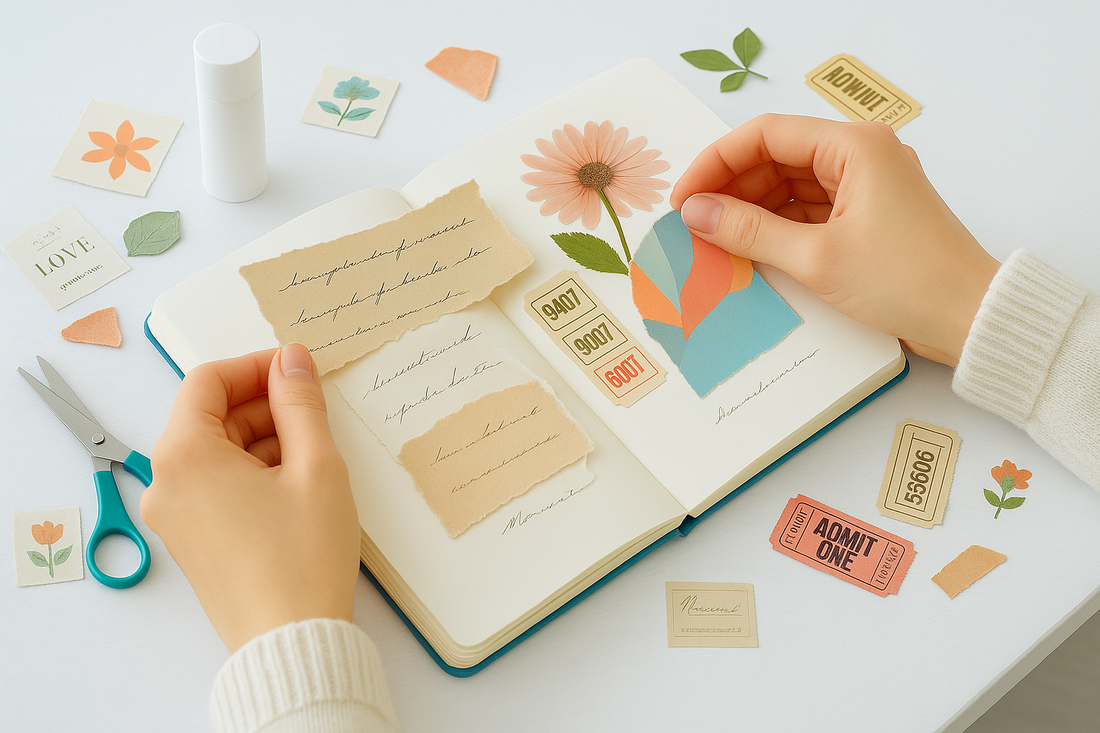
Glue It Down, Let It Go: The Quiet Magic of Journaling with Ephemera.
Share
Glue It Down, Let It Go.
There’s something strangely comforting about sticking an old bus ticket into a notebook.
Maybe it’s not about the ticket. Maybe it’s about keeping a piece of a moment—one you can’t explain, but don’t want to forget.
That’s what journaling with ephemera is about. Tiny fragments of real life, pressed onto a page. Not for anyone else. Not for Pinterest. Just for you.
It’s storytelling in scraps. It’s therapy without the clipboard. And science backs it: this low-fi, humble practice can actually shift your mental health in powerful ways.
Let’s get into it.
First, What Even Is Ephemera?
Ephemera means the stuff that usually ends up in the bin.
Used stamps. Tags. Wrappers. Menus. Old receipts. That weird postcard you found at the op shop. The tissue paper from your birthday present. The scribbled note from someone you miss.
But instead of throwing it all away, you keep it. Not because it’s useful—but because it’s yours.
And when you put those pieces in a journal, alongside a thought or a sentence or a sketchy doodle, something clicks into place. You don’t just remember—you feel it again.
Mental Health, Meet Glue Stick
Here’s the not-so-secret truth: journaling is good for your brain.
But not just any journaling. The kind where you slow down. Where you sit with your feelings, even if you don’t name them. Where you grab a pen, a ticket stub, and let your hands take over.
The benefits are real:
Emotional processing
Writing—even in short bursts—helps your brain make sense of stuff. According to psychologist James Pennebaker, expressive writing reduces stress and improves immune function. That’s not fluff—that’s data. But not everyone enjoys writing, I have dyslexia and processing writing is tiring, challenging at times.
Less mental clutter
Journaling in any form, gets the thoughts out of your head and onto paper, where they’re easier to look at, process (and less likely to keep you up at 2am with feeling shit).
Increased resilience
Looking back on your journals can show you how much you’ve survived, how you’ve grown, and how you made it through stuff you thought would break you. And help you wade through the inevitable brain fog.
When you add ephemera to that? It simply hits differently.
Why Ephemera Helps You Tell the Real Story
Sometimes it’s hard to find the right words. That’s okay.
Instead, you can tell your story with a receipt, a coffee sleeve, or a torn magazine clipping. These things aren’t just junk. They’re proof. Evidence. Markers of where you’ve been and who you were at that moment.
They ground you.
When life feels floaty or fast or messy, sticking something down can make you feel real again. “I was here. I lived this day. This mattered, even if no one else saw it.”
They make the abstract… visible.
A broken necklace clasp might mean more to you than a whole page of writing about grief. A bright candy wrapper might hold more joy than you can put into words. Ephemera gives shape to feelings.
They let you reclaim the story.
Not everything that happens to you is beautiful. But in your journal, you get to decide what stays. What matters. What’s worth remembering.
What the Research Says (And Why It Matters)
Beyond the artsy side of things, journaling is actually a well-documented wellness tool.
According to a review in Advances in Psychiatric Treatment (2015), journaling supports mental health by helping people understand their emotions, manage stress, and develop healthier coping strategies.
Other studies have found that journaling can:
-
Reduce symptoms of depression and anxiety
-
Help manage PTSD and trauma-related stress
-
Improve cognitive function
-
Even help physical healing (yes, really—some wounds heal faster when you write!)
Adding visuals and tactile materials, like ephemera, only increases the therapeutic effect by engaging more parts of the brain. It becomes a full-body experience—not just a mental one.

How to Start (Without Overthinking It)
You don’t need fancy supplies.
You don’t need to be “good” at journaling. You don’t need a system or a prompt or a plan.
You just need somewhere to stick things.
Try this:
-
Keep a shoebox, baggie, or drawer for scraps. Anything you like the look or feel of.
-
Choose one item at random.
-
Stick it in your journal.
-
Write one sentence about it. Or none.
-
Add colour. Or don’t.
-
Keep going.
There’s no wrong way. There is only your way.
Let the Mess Be the Point
Some days you might journal like a poet. Other days, it’s a smudge of highlighter and a movie stub.
That’s okay.
Your journal isn’t a masterpiece. It’s a mirror. It shows you the stuff that matters when no one else is looking. It helps you catch the tiny, brilliant moments that would otherwise disappear.
And over time? You’ll see a story forming. One you didn’t even know you were telling.
One that feels honest.
Yours.
In the End, It’s Not Just Paper
Journaling with ephemera isn’t about making something pretty. It’s about making something true.
It’s about choosing to remember. To reflect. To honour the quiet parts of your life that rarely get seen.
So tape it down. Scribble in the margin. Smudge the ink. Add that weird sticker. Let it be messy.
Because sometimes, healing doesn’t look like a perfect quote on a clean page.
Sometimes it looks like a coffee-stained receipt.
A crooked sketch.
A scrap of paper that reminds you you’re still here.
Still living.
